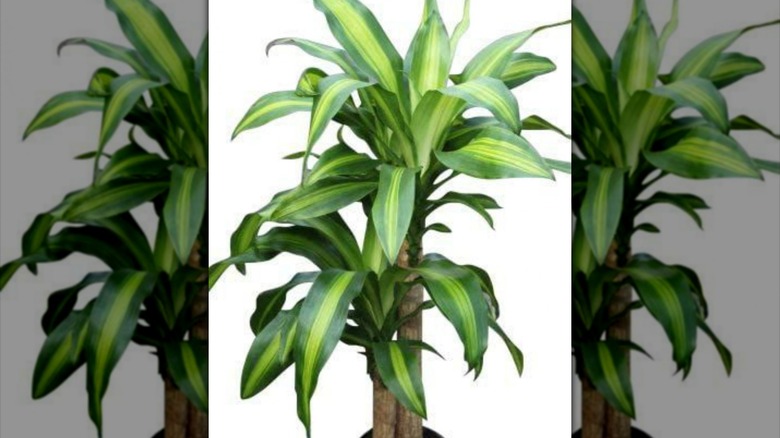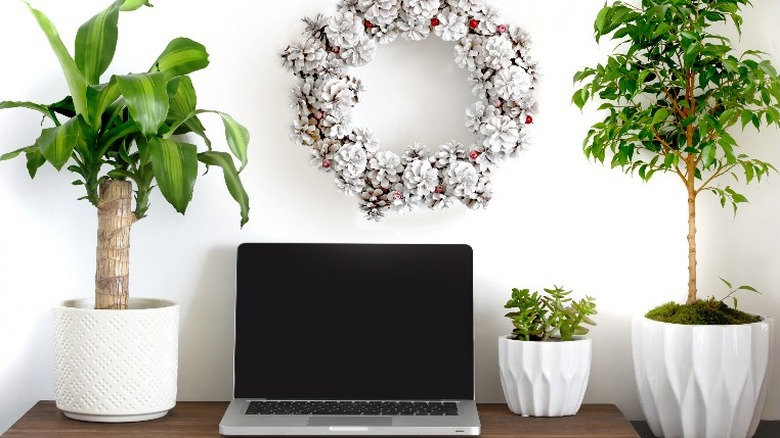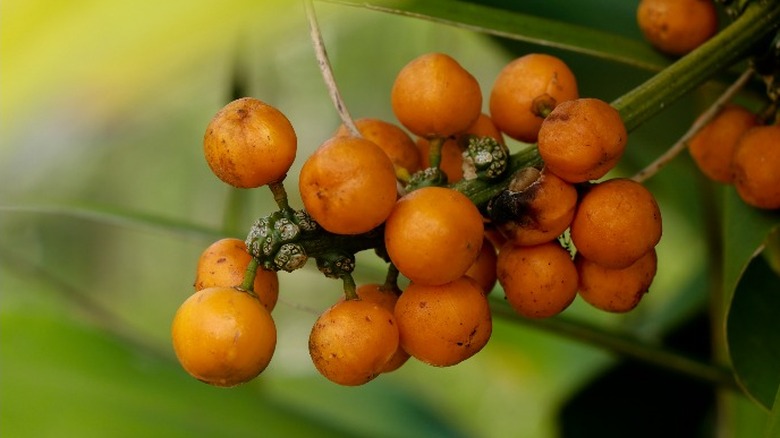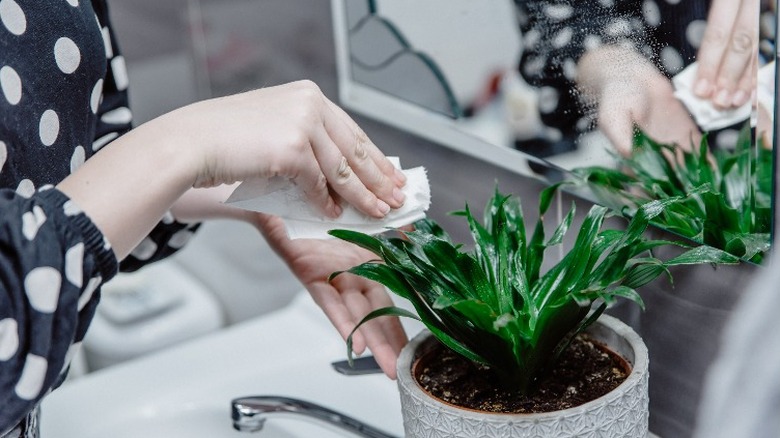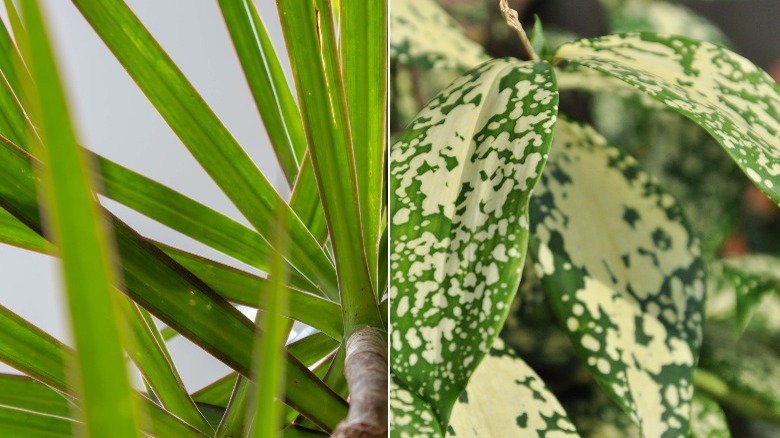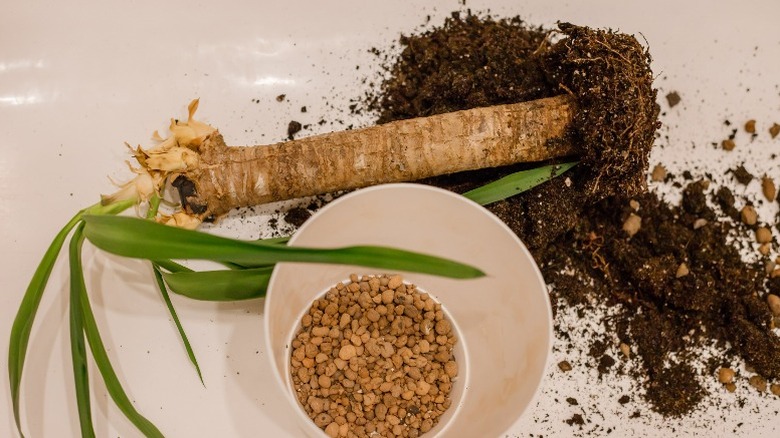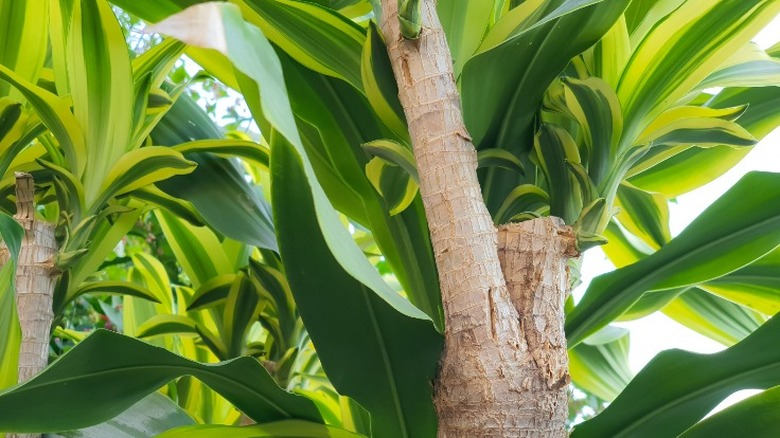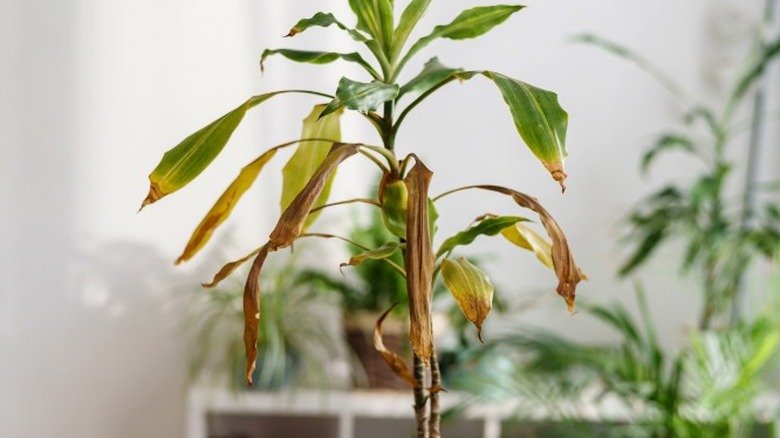How To Grow And Take Care Of Corn Plants
The corn plant, also known as the mass cane plant (Dracaena fragrans "Massangeana") is a cultivar of the Dracaena fragrans species, which originated in tropical African countries, writes Evergreen Seeds. The common name is corn plant because its broad leaves and stalk resemble plants that produce corn. In its native environment, the plant's white flowers give off a strong, sweet fragrance at night that is noticeable for hundreds of feet. It's extremely rare for it to bloom indoors.
Corn plants are popular houseplants because of their leafy appearance and easy-care nature. They grow best in bright light near a window, but not in direct sunlight, and prefer moist soil, but tolerate dry soil from time to time. If you don't have a self-described "green thumb," this may be a good plant for you. Tip: when you search online for information on corn plants, search by their scientific name, Dracaena, or you will end up with information on actual corn-growing plants.
The corn plant is one of several varieties of Dracaena plants. The main characteristic of a corn plant is a straight trunk with a crown of long, broad leaves which arch back and hang down from the plant, per Gardenia. The leaves of have one or more lime-green stripes in the center. It grows slowly but can reach a height of 6 feet or more indoors. Cutting the cane back in spring or early fall will control its growth. Dracaena can be kept small and used as a table-top plant.
How to use corn plants in garden
The corn plant's beautiful leaf color and woody trunk fit into any décor scheme, accented with the right decorative container. Since corn plants do not need direct sunlight, you can use them to fill in an awkward or empty space as long as the room gets good natural light. Another good reason to buy a corn plant is the way it helps clean the toxins from the air. In NASA's clean air study, Dracaena varieties "marginata," "Janet Craig," "Warneckei," and "Massangeana" were found to be among the best houseplants at removing indoor air toxins found in homes such as trichloroethylene (TCE), formaldehyde, and benzene.
In their native tropical environments, corn plants can grow up to 50 feet tall! They have been used to create living fences and wind breaks when cultivated in the tropics. However, they are easily naturalized and considered an invasive plant displacing native species. In Palm Beach County, Florida, a corn plant that was planted outside spread south and can now be found all the way down to the Florida Keys, according to an article in The Palm Beach Post. Corn plants are not considered an invasive species in Florida, but much like other tourists they come to visit and stay. Check your state's prohibited plant list before your take your corn plant out for a breath of fresh air. Even if you plan to keep it in a container outside, it may have other ideas.
How to grow corn plants
Typically, corn plants are purchased from a garden center but you can grow them from seeds. You'll need the following to get started: seeds that are labeled dracaena fragrans massangeana, seed starting mix, seedling starter tray, heat germination mat, plastic wrap, several 3-inch containers, and potting soil.
Start by soaking the seeds in room temperature water for three to five days, per The Spruce. This helps them germinate more easily. You will not see any sprouts yet. Next, put two to three seeds in each cell of your seedling start tray that you've filled with a starter mix, and cover lightly with the same mix. The seeds germinate in temperatures between 68 to 80 degrees Fahrenheit. To provide this warmth, use a heat germination mat and grow seedlings in bright, indirect sunlight or under a grow light. Cover the seedlings with clear plastic to create a greenhouse-like atmosphere. Water as needed to keep the seed starting mix lightly moist. If you notice a buildup of condensation, loosen the plastic or poke several holes in it. Remove the plastic covering when the seeds germinate and sprout in four to six weeks.
Transplant each individual seedling into a 3-inch pot filled with standard potting soil when each seedling has two true leaves. Make sure the container has several drainage holes. Fertilize the seedlings occasionally using a solution of water-soluble fertilizer that has been diluted by half.
How to care for corn plants
The best way to care for your corn plant is keep it out of direct sunlight and water it weekly when the soil is dry 1 to 2 inches below the surface. Corn plants love humidity but will settle for having their leaves misted or wiped with a damp cloth. They enjoy a temperature range from 60 to 75 degrees Fahrenheit, according to Leafy Place. Cold drafts from open windows or air conditioning are not good for corn plants, nor are hot radiators. Extreme temperatures will cause the leaves to curl and droop. If you bring your plant outside, the temperature has to be above 60 degrees F.
If you overwater, or don't provide enough water, the leaves may start to yellow, and the tips will become brown. You can cut off the dried tips and remove dead leaves. Smart Garden & Home reports that corn plants do best with distilled, filtered water, or rainwater. Tap water contains chemicals like fluoride or chlorine that can build up in the soil. If you use tap water, let it sit in a container for 24 hours so the chemicals can evaporate.
As previously mentioned, fertilize corn plants monthly from spring until fall with a balanced, water-soluble fertilizer diluted to half strength. Since corn plants are slow growers their fertilizer requirements are low. Too much fertilizer can cause mineral burn which will make the leaves look like they've been scorched by high heat.
Varieties of corn plants
In addition to the corn plant, there are many other varieties of dracaena, some of which are:
- Lucky bamboo (Dracaena sanderiana), which is not a bamboo plant at all. The stalk looks very similar to bamboo and has sparse leaves. It can be grown in soil but is often grown on a base of pebbles in a container of water. Change the water every few weeks using distilled water.
- Striped dracaena (Dracaena deremensis warneckii ulyses) has dark green leaves and creamy white stripes. The cane and the leaves are much more narrow than those of the corn plant.
- Dracaena tree (Dracaena arborea) resembles a very small palm tree with narrow, upright leaves that are green with creamy white edges.
- Canary Islands dragon tree (Dracaena draco) has a broad trunk and long, spikey leaves that grow in a thick fan shape.
- Gold dust (Dracaena surculosa) has more leaf than stem, compared to other dracaena varieties. It has shorter, oval-shaped leaves that come to a point, and is speckled with creamy white.
- Madigascar dragon tree (Dracaena marginata) features tall, skinny trunks that are topped with green sprouts of long, elegant, red-tipped leaves.
Although dracaenas are not toxic to humans they should not be consumed. However, they are considered toxic to dogs, cats and horses, according to the ASPCA, and may cause vomiting, pupil dilation and other symptoms. Contact your vet immediately if you think your pet has eaten this plant.
How to repot corn plants
Corn plants are slow growing plants that prefer to be slightly root-bound, according to Leafy Place. They may only need to be repotted every two to three years. The plant is root-bound if you can see the roots growing through the drainage hole or above the soil. The best time to repot is in early spring at the start of the growing season. You will need the following materials: a container with drainage holes that is 2 to 3 inches wider than the previous container, potting soil, a spoon. If your plant is large, you may need someone to help you lift it.
Water the plant lightly the day before you repot it. Use new potting soil as the nutrients may be depleted from old soil. If the plant is small, lay it on its side and gently slide it out. If it's a large plant leave it standing up right. You may need to use a blunt knife to run around the inside edge of the pot to loosen it.
Cut off any decaying roots and loosen the soil around them. Set the plant in the new container that has 2 inches of dampened potting soil, then add soil up to where the cane is growing from the roots. Pat down gently around the base of the plant to anchor it. Water the plant immediately and place it in the same spot where it had been growing until it recovers.
Pruning corn plants
Corn plants can grow up to 6-feet tall indoors. You can contain the growth by pruning them in the early spring or fall, per Leafy Place. Use pruning shears with a sharp blade, and make sure the blades have been cleaned with a mixture of bleach and water to kill off any pathogens. Cut the cane to the desired height, below the crown of the leaves growing from the top of the cane and remove the whole top. It may seem drastic, but in a few weeks, you will see new leaves growing from the top of the cane. Be sure you get at least one leaf node, says Houseplant Central, which is where the cluster of leaves grows from the cane.
You can propagate this cutting by placing the cut end in water and putting it in a warm spot. The roots should start to grow quickly, as long as you keep it warm. Plant the cutting in potting soil when the roots are 1 to 2 inches long. Alternatively, you can dip the end of the cutting in rooting powder and plant it directly in potting soil.
Pests and other corn plant problems
The corn plan rarely has issues with plant diseases, according to Gardening Know How. Most of the issues related to the plant's health have to do with their care. Tap water, as mentioned previously, contains chemicals which can cause the leaves to dry up and turn brown. This won't cause your plant to die, but it will not look as healthy. Too much or too little water can also cause the leaves to turn yellow or brown.
If your corn plant is living in a very dry environment, it can become susceptible to spider mites and or scale infestations. Spider mites are not visible to the human eye, but if the leaves begin to show small brown or yellow specks or spots your plant may have this pest. To wipe out both of these pests, use an insecticide spray and follow the directions on the bottle. With a little attention, you can enjoy a beautiful, easy-to-grow houseplant for years!
